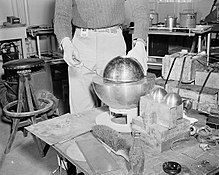This Day in History: On 21 May 1946, with seven colleagues watching, physicist Louis Slotin performed an experiment that involved the creation of one of the first steps of a fission reaction by placing two half-spheres of beryllium (a neutron reflector) around a 3.5-inch-diameter plutonium core. The experiment used a 13.7 lb plutonium core, later called the "demon core" for its role in two accidents. Slotin grasped the upper 9-inch beryllium hemisphere with his left hand through a thumb hole at the top while he maintained the separation of the half-spheres using the blade of a screwdriver with his right hand, having removed the shims normally used. Using a screwdriver was not a normal part of the experimental protocol.
At 3:20 p.m., the screwdriver slipped and the upper beryllium hemisphere fell, causing a "prompt critical" reaction and a burst of hard radiation. At the time, the scientists in the room observed the blue glow of air ionization and felt a heat wave. Slotin experienced a sour taste in his mouth and an intense burning sensation in his left hand. He jerked his left hand upward, lifting the upper beryllium hemisphere, and dropped it to the floor, ending the reaction. He had already been exposed to a lethal dose of neutron radiation. Slotin's colleagues rushed him to the hospital, but the radiation damage was irreversible. The position of Slotin's body over the apparatus shielded the others from much of the neutron radiation.
Scientists referred to this flirting with the possibility of a nuclear chain reaction as "tickling the dragon's tail", based on a remark by physicist Richard Feynman, who compared the experiments to "tickling the tail of a sleeping dragon" (which means to do something that has a risk of going catastrophically wrong.)
The History and Mystery of Alchemy is now available on Amazon...and it is only 99 cents.



No comments:
Post a Comment